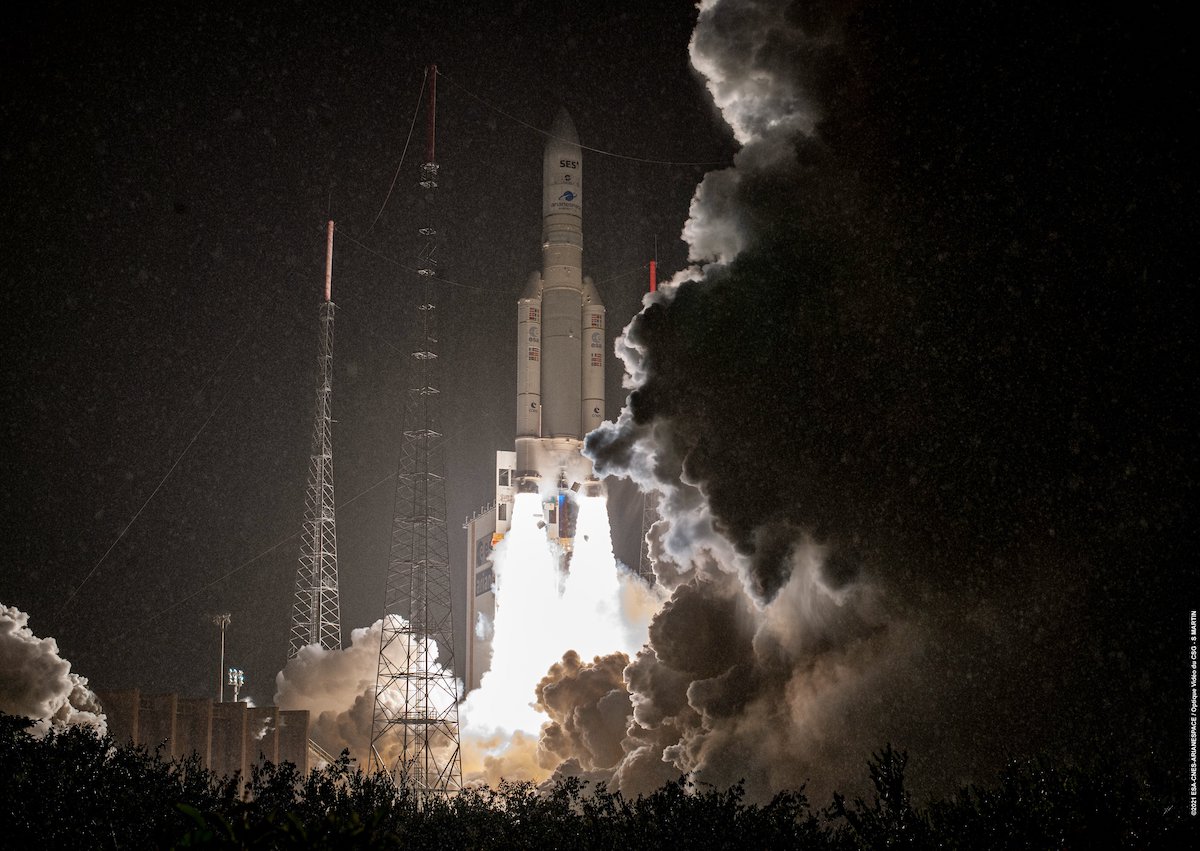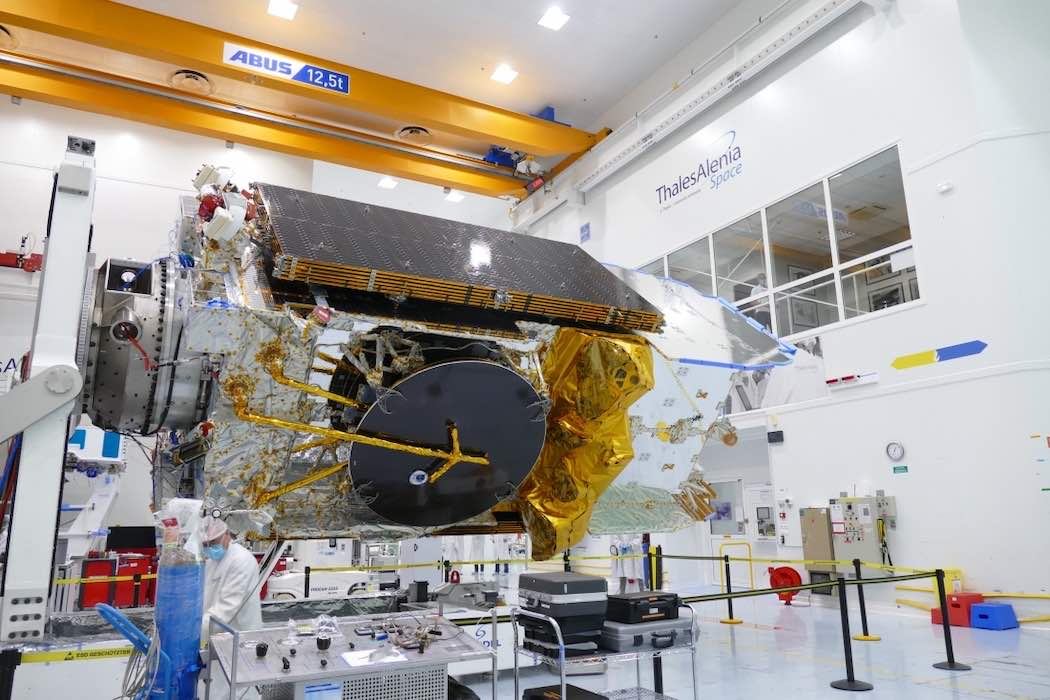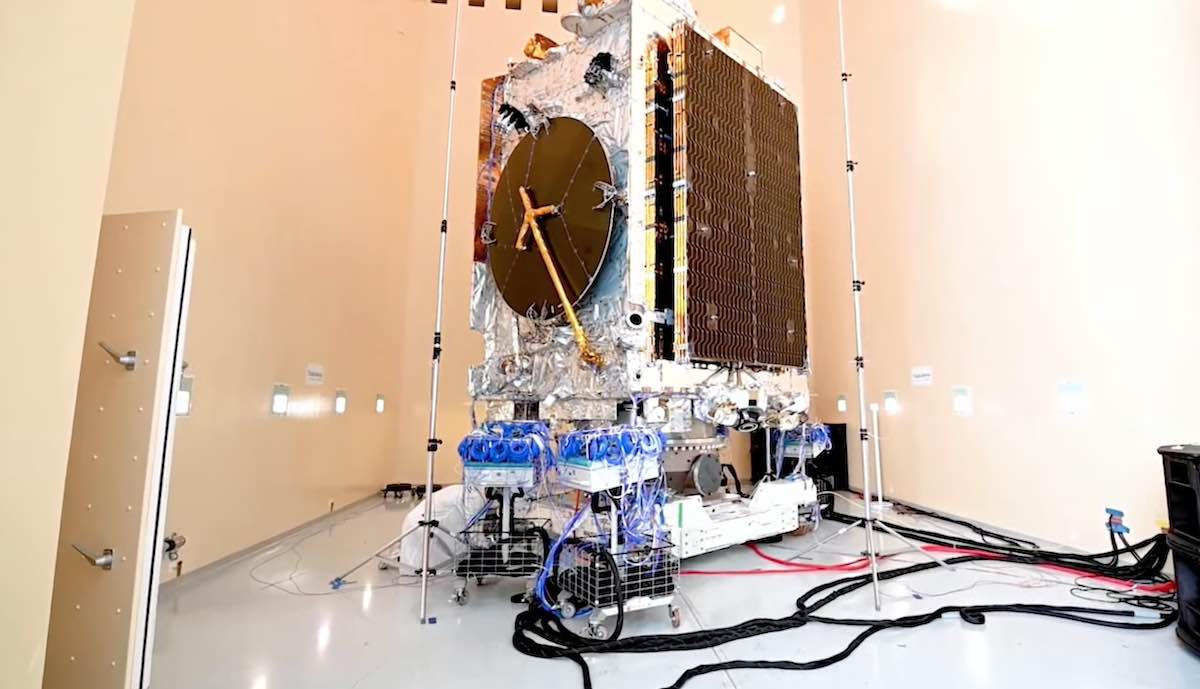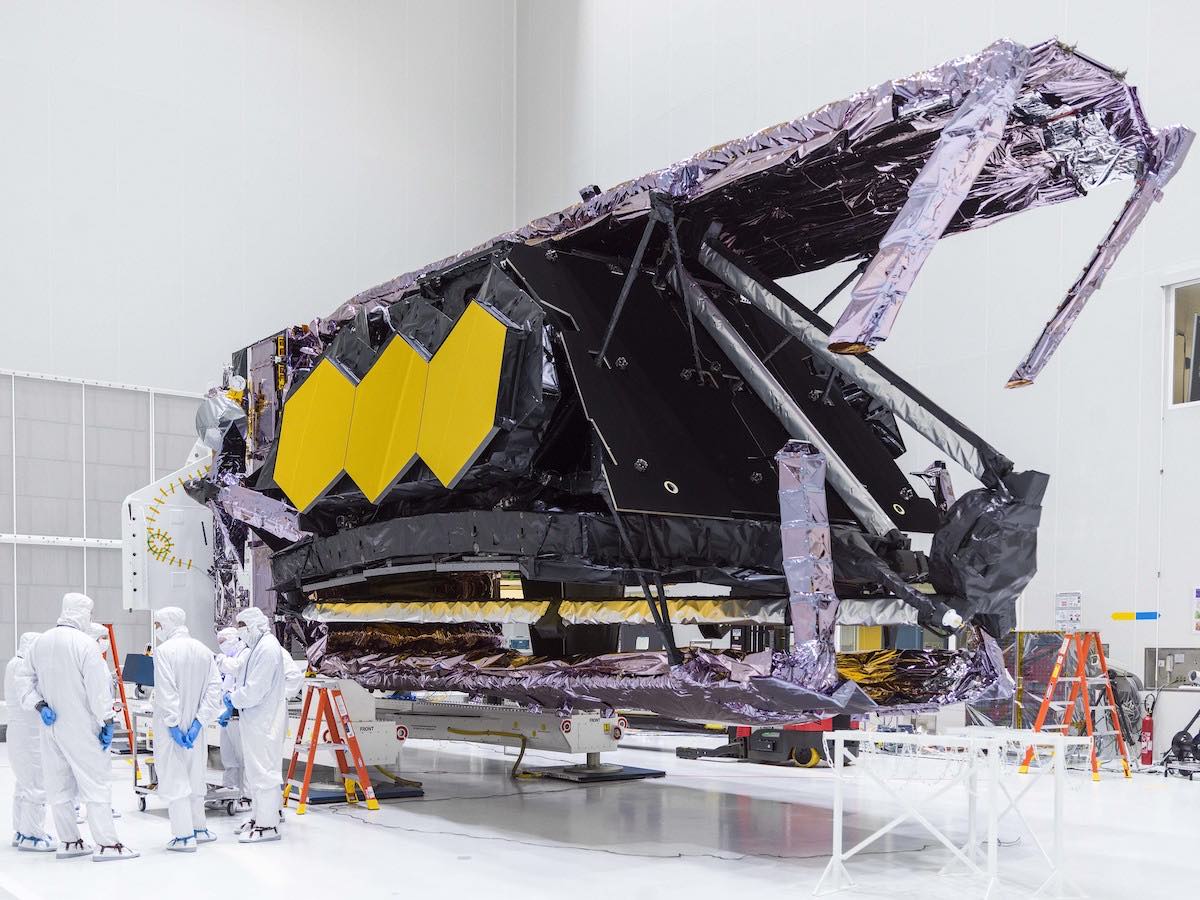Space News & Blog Articles
Arianespace breaks payload mass record on final Ariane 5 launch before Webb
 An Ariane 5 rocket lifts off from the Guiana Space Center with the SES 17 and Syracuse 4A communications satellites. Credit: ESA/CNES/Arianespace/S. Martin
An Ariane 5 rocket lifts off from the Guiana Space Center with the SES 17 and Syracuse 4A communications satellites. Credit: ESA/CNES/Arianespace/S. Martin
A European Ariane 5 rocket fired into space Saturday night from French Guiana with a commercial broadband satellite for SES and a French military telecom craft, setting a new payload mass record for geostationary transfer orbit on the final Ariane 5 flight before launch of the James Webb Space Telescope in December.
Running a day late after a ground system issue forced a 24-hour delay from Friday, teams pumped cryogenic liquid hydrogen and liquid oxygen into the Ariane 5 launcher’s main stage and upper stage Saturday afternoon on the ELA-3 launch pad at the Guiana Space Center in South America.
The Ariane 5’s countdown stopped five minutes before the rocket’s first launch opportunity Saturday night. After a 67-minute hold to allow engineers to analyze pressure readings in the Ariane 5’s main stage, the countdown resumed and the rocket’s Vulcain 2 main engine flashed to life at 10:10 p.m. EDT (0210 GMT).
Seven seconds later, the Ariane 5’s twin solid rocket boosters ignited to propel the launcher off the pad with 2.9 million pounds of thrust.
The Ariane 5 lifted off at 11:10 p.m. local time in French Guiana, darting though a cloud layer as it accelerated due east from the spaceport on the northern coast of South America.
The rocket jettisoned its two spent solid rocket booster casings nearly two-and-a-half minutes into the mission. The Ariane 5’s Swiss-made payload shroud released in two halves moments later, once the rocket climbed above the dense, lower layers of the atmosphere.
The main stage continued firing its Vulcain 2 main engine until nearly nine minutes into the flight, before switching off and dropping away to fall back into the atmosphere off the coast of Africa.
An upper stage powered by a hydrogen-fueled HM7B engine ignited for a 16-minute burn to inject the SES 17 and Syracuse 4A satellites into an oval-shaped geostationary transfer orbit stretching nearly 22,000 miles (36,000 kilometers) above the planet.
The Ariane 5 released each satellite right on time, first deploying the SES 17 spacecraft from the upper position on the rocket’s dual-payload stack nearly 30 minutes after liftoff. After casting off an adapter structure, the Ariane 5 deployed Syracuse 4A about nine minutes later.
 The SES 17 satellite during integration and testing at Thales Alenia Space’s factory in Cannes, France. Credit: Marie-Ange Sanguy / Thales Alenia Space
The SES 17 satellite during integration and testing at Thales Alenia Space’s factory in Cannes, France. Credit: Marie-Ange Sanguy / Thales Alenia Space
Arianespace, the French company that manages Ariane 5 launch operations, declared success on the mission. Designated VA255 in Arianespace’s flight sequence, the launch Saturday night was the 111th flight of an Ariane 5 rocket since 1996, and the 255th mission overall with the Ariane rocket family.
Built Thales Alenia Space, the SES 17 communications satellite will provide internet connectivity to airline passengers over the Americas, the Caribbean, and the Atlantic Ocean for SES of Luxembourg. The fully fueled satellite weighed 14,133 pounds (6,411 kilograms) at launch, according to Arianespace’s launch press kit.
SES 17 is the largest satellite ever procured by SES, and the largest spacecraft ever built by Thales. It carries a new digital payload controller, developed in a public-private partnership with ESA, that is capable of re-programming the satellites’s nearly 200 spot beams, adjusting power and frequency allocations to respond to changing customer needs.
“Thanks to Arianespace, SES-17 is now on its way to orbit,” said Steve Collar, CEO of SES. “We are looking forward to SES customers being able to leverage the high throughput, global reach and low-latency of SES’s multi-orbit, interoperable Ka-band satellite network comprising SES-17 and our upcoming O3b mPOWER constellation.”
The SES 17 satellite also carries a mechanically pumped loop cooling system, the first such active thermal control loop to be used on a large commercial communications spacecraft. Previous commercial telecom satellites used passive thermal control systems, or heat pipes, to keep their internal electronics at proper temperatures.
The 8,492-pound (3,852-kilogram) Syracuse 4A spacecraft, also built by Thales Alenia Space, will provide communications services for the French military. The satellite will relay secure communications between French military aircraft, armored ground vehicles, and naval vessels, including submarines.
The Syracuse 4 program replaces the Syracuse 3 generation, which comprises two French satellites launched in 2005 and 2006, and a joint spacecraft with Italy that went into orbit in 2015. The Syracuse satellites provide relay services for French military forces deployed and on the move in areas outside the each of terrestrial communications.
“All of these activities require constant, reliable communications, and only space telecommunication can provide that,” and Commander Ludovic Esquivié, Syracuse program officer at French Space Command. “Syracuse … is a secure communication system totally controlled by the armed forces, and hardened against external aggressions.”
The French defense ministry announced in 2019 that the new generation of Syracuse satellites would have cameras to help identify and monitor possible attackers. The Syracuse 4 satellites are also resistant to jamming, and provide higher data relay rates and improved flexibility over the aging Syracuse 3 satellites.
“These satellites are exposed to, or must be capable of dealing with, all kinds of threats, including a nuclear threat, but also threats in terms of cyber security or cyber attacks,” said Hervé Derrey, CEO of Thales Alenia Space.
 The Syracuse 4A satellite. Credit: DGA
The Syracuse 4A satellite. Credit: DGA
SES 17 and Syracuse 4A will use plasma thrusters over the next few months to circularize their orbits more than 22,000 miles over the equator. Once in geostationary orbit, the satellites will have fixed geographic coverage zones as they more around Earth with the planet’s rotation.
Saturday night’s mission set two records.
The combined launch weight of the SES 17 and Syracuse 4A satellites was 22,626 pounds (10,263 kilograms). The two spacecraft comprised the heaviest payload stack ever to be launched into geostationary transfer orbit, a typical drop-off orbit for large communications satellites.
The Ariane 5 rocket Saturday night flew with a raising cylinder at the base of the payload fairing that increased the launcher’s height by 5 feet (1.5 meters) relative to the standard launcher design. The change gave the rocket a total height of 184 feet (56.3 meters), making it the tallest Ariane 5 to ever fly.
The flight Saturday night helped clear the way for the next Ariane 5 mission to launch the $10 billion James Webb Space Telescope.
The Ariane 5 is one of the most reliable launch vehicles in the world, with just one partial failure in its last 97 flights. The European Space Agency is paying for Webb’s launch as part of its contribution to the mission. NASA paid the bulk of Webb’s development costs, and the Canadian Space Agency is the third partner on the observatory.
NASA engineers helped ESA and Arianespace assess the Ariane 5 rocket’s readiness to launch Webb, the most expensive robotic space mission in history. The launch Saturday was the final test before Webb is mounted to the next Ariane 5 for a liftoff scheduled for Dec. 18.
The Launch Services Program at Kennedy Space Center, which provides oversight for launches carrying NASA science missions to space, took on a consulting role for the James Webb Space Space Telescope.
“I think that helps calm some folks’ feelings, or perhaps perceptions, of why in the world are we launching this on a foreign vehicle,” said Omar Baez, a launch director at Kennedy, in a recent interview with Spaceflight Now.
Baez said he took his first trip to the Ariane 5 launch base in Kourou, French Guiana, two decades ago to start evaluating facilities at the spaceport, which is managed by CNES, the French space agency.
“It’s touchy because you’re going up against Arianespace and CNES, and you’re a foreign agent, but we have worked well together,” Baez said.
He said NASA assigned experts in spacecraft processing, mission integration, and risk management as consultants to work with ESA and Arianespace ahead of Webb’s launch.
“Our risk manager has been following how the French and ESA folks bubble up any problems that Arianespace may have, and it’s very similar to the system we have here, with regard to insight and oversight by government agencies,” Baez said. “So we take credit for some of that insight by seeing that they have the same type of rigor that we show when we fly one of our precious payloads.”
“Ariane 5 demonstrates continuous improvement with each launch,” said Daniel Neuenschwander, ESA’s director of space transportation, in a statement after Saturday night’s launch. “The success today of launch VA255 and the success of VA254 last July were crucial to move towards Ariane 5’s December launch carrying the James Webb Space Telescope.”
 The James Webb Space Telescope is seen inside the S5C payload processing facility at the Guiana Space Center in Kourou, French Guiana. Credit: NASA/Chris Gunn
The James Webb Space Telescope is seen inside the S5C payload processing facility at the Guiana Space Center in Kourou, French Guiana. Credit: NASA/Chris Gunn
In their analyses to ensure the Ariane 5 is ready to launch Webb, engineers in Europe and the United States have focused on the rocket’s payload fairing, or nose cone, which protects payloads during the first few minutes of flight through the atmosphere. The shroud jettisons in two pieces a few minutes after launch, exposing satellites for separation from the rocket once in orbit.
JWST will fold up origami-style to fit under the Ariane 5 rocket’s payload shroud, then unfurl solar panels, antennas, a segmented mirror array, and a thermal sunshield the size of a tennis court after separating from the Ariane 5 on the way to an observing post nearly a million miles (1.5 million kilometers) from Earth.
Once in position, JWST’s telescope — the largest ever flown in space — and four science instruments will peer into the distant universe, studying the turbulent aftermath of the Big Bang, the formation of galaxies and the environments of planets around other stars.
The Ariane 5 payload shroud is made by RUAG Space in Switzerland.
Engineers introduced modifications to the Ariane 5’s payload fairing to reduce vibrations imparted on the satellites during separation of the nose cone.
ESA, Arianespace and RUAG also changed the design of vents on the Ariane 5’s payload shroud to address a concern that a depressurization event could damage the Webb observatory when the fairing jettisons after liftoff. Engineers were concerned residual air trapped in Webb’s folded sunshield membranes could cause an “over-stress condition” at the time of fairing separation.
Baez said NASA engineers based at Kennedy Space Center were “very instrumental” in discovering an issue with how the Ariane 5 fairing depressurizes during ascent.
“We were able to, in cooperation with our French partners, instrument the fairing on previous flights that captured that environment and make sure that we had accurate information,” Baez said. “And, in fact, we did find a problem. We had to work on a scheme to be able to vent that fairing properly on its ascent.”
This email address is being protected from spambots. You need JavaScript enabled to view it. the author.
Follow Stephen Clark on Twitter: @StephenClark1.
When you subscribe to the SpaceZE News Feed, we will send you an e-mail when there are new updates on the site so you wouldn't miss them.

